звоните: +7 495 204-207-8
e-mail: art@quartagallery.ru
Recent posts
- Необычная судьба тверской художницы Наталии Пономаревой
- Жемчужина деревянной архитектуры русского севера
- Первая народная галерея в Льялово
- Online auction - a practical instruction. How to take part?
- История русской анимации и коллекционирование «истории» мультипликационных фильмов
- История в гравюрах и литографиях уникального печатного издания «Революционная Москва: Третьему конгрессу Коммунистического Интернационала». 1921
- Painting as a Gift
- What happened to frescoes of Kievskaya Metro Station?
Meeting with the Master
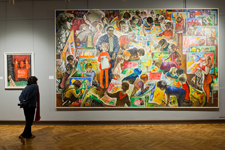
About the trip to the exhibition of the artist Mai Dantsig, which was held in the National Museum of Belarus in Minsk in Autumn 2015 devoted to the 85th anniversary of the Master.
The visit to the jubilee exhibition of the People’s Artist of Belorussia May Dantsig at the National Museum of Fine Arts of the Republic of Belarus had been on our schedule since the moment we learnt it would open in autumn 2015. I was eager to get to the opening of the show on October 15th but our own exhibition in Moscow would not let us do that. However, it turned out for the best. Firstly, we came to the museum on a rainy weekday exactly 10 minutes after its opening, and though there was already a short line to the ticket office, it was not crowded and there were no reporters or hundreds of the amazing Minsk master’s admirers. And secondly, and that was the most important point, we were lucky to meet May Volfovich in person. He had had a chance to get some rest after the tense pre-opening week and relax from the pandemonium of the fussy holiday aura of the Opening Day. We saw him at home in a nice warmly atmosphere and managed to discuss a lot of things: the exhibition, the art and life, in general.
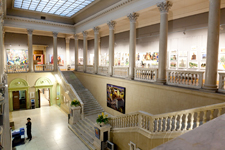
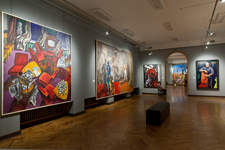
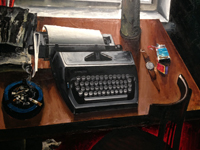
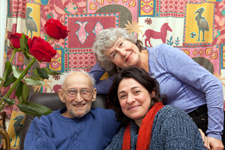
I came to know this wonderful man in 2011 when I arrived in Minsk with my colleagues in search of material for the exhibition of Belorussian artists to be organized in the private gallery I worked at then. May Volfovich dazzled me first by his persona during our meeting at his studio. He was a man of miraculous energy, exuding great love of life; his speech was an amusing flow of captivating anecdotes, audacious sense of humor and philosophical reflections which were never boring and of which some could be easily transformed into historic maxims. Listening to Damzig is almost a gourmet pleasure — the more you listen the more you want to hear. He spoke both about his childhood and the last train the family took when fleeing Minsk the day before its occupation, about his studies at the Surikov’s Institute in Moscow and his own creative activity, and, of course, about art on the whole. If you add contemplating his artworks to that you will see the figure of the Master evolving in its grandeur and uniqueness.
During that trip we were stunned by the artist’s graphics, which we had not seen before, and it was exhibited in its full volume for the first time. There were more than a hundred artworks (pencil, pastel, coal) of the 1950-70s period including portraits, genre scenes, everyday sketches, theatrical costumes, all executed unbelievably accurately and professionally, creating at the same time the feeling of effortlessness. Each work was a live picture with emotions conveyed so realistically and the details creating such a real-life atmosphere, that you can’t help believing the Master taking you back to the old days.
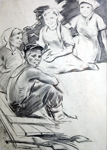
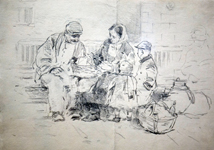
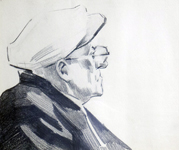
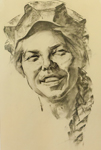
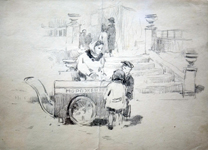
Nevertheless, Dantsig is more famous for his monumental artworks of both the Soviet and the modern periods. The museum collection owns the best artworks of the painter created during the last 60 years, all of them were presented at the jubilee show: two floors of incredible energy, power and history. Walking from one hall to another, you come across enormous canvases with strong and handsome people, grand cities, landmark events of the epoch, and you immerse into the artist’s world full of love and life in all their aspects. Meanwhile, the creativity of May Dantsig is not just a story or a history of what you have seen; it is loaded with symbols and undercurrents.
Students on a bridge running towards spring; move-ins in an empty apartment where their new life is going to start; a girl on a balcony watching the construction of a new city, a worker with a baby in his hands beside his young wife — they are all paintings of the 1950s-1960s telling about youth and aspirations, about belief in the future and a strive to make it magnificent.
Two halls of the exhibition were dedicated only to the Great Patriotic War and to the hundreds of thousands of soldiers who never returned home from battle. A huge forest of birch trees which trunks carry the photos is a multi-meter collage and a tribute to the memory of the partisans perished in Belorussia’s woods.
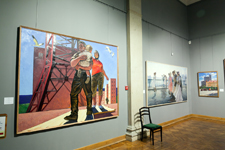
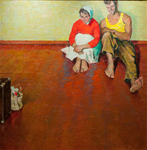
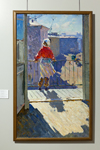
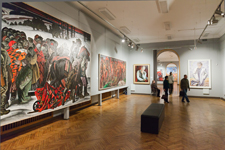
May Dantsig is an artist of a broad creative scope and he works in practically every genre, including easel and wall painting, narrative painting, portrait, landscape and still life. He creates the biography of Minsk in art combing monumental expressiveness and exquisite shapes, as well as subtle coloristic solutions and carefully thought-out angles. Many of his canvases, such as «My Minsk» (1967) and «My City, Ancient, Young» (1972) have become the classics and part of the golden fund of Belorussian art. His city landscapes are characterized by originality being multidimensional with dynamic angles. Despite the laconism of his artistic language Dantsig goes for rich art and bright colors, having a tendency for reddish tints. His natural color expression makes him akin the Fauvists. Dantsig’s portraits amaze with their profound understanding of the personality and the depth of his penetration into the human psyche.
Being a bright representative of the high traditions of realistic art Dantsig is convinced in the need to take care of them, to rethink them creatively and contribute to them, especially now when the preference is frequently given to plain dilettantism.
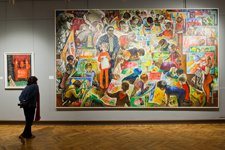
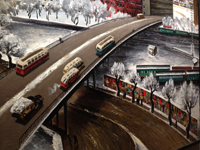
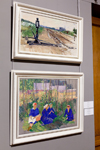
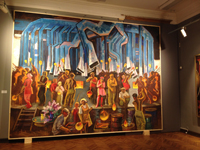
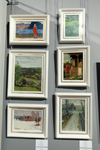
QUARTA Gallery presents the splendid artworks of May Dantsig of the early period of his creative activity:
